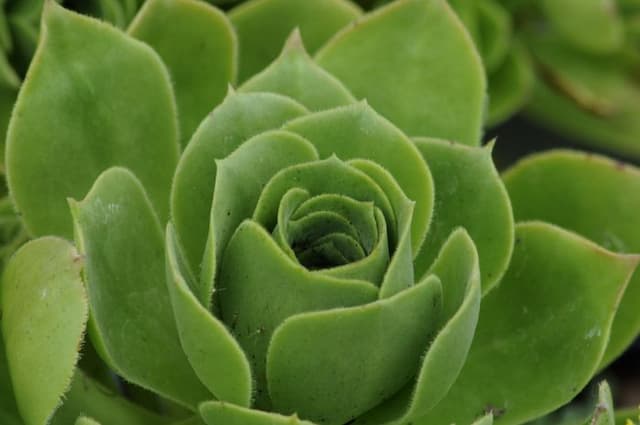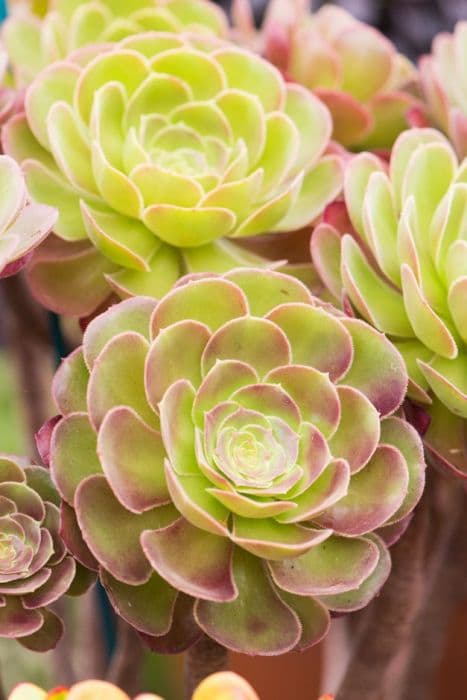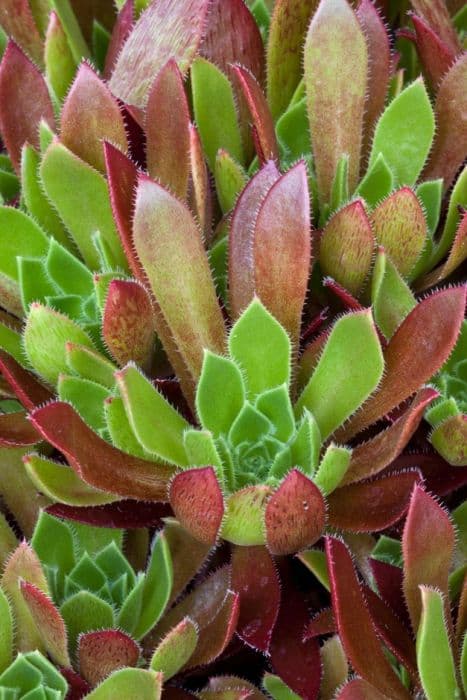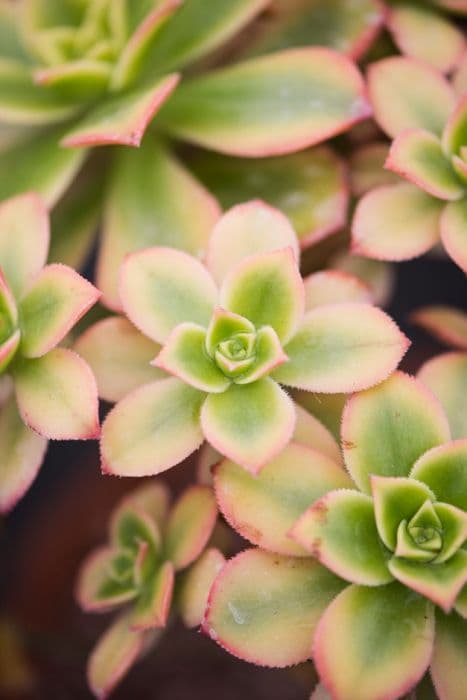Desert Rosewort Rosularia chrysantha

ABOUT
Rosularia chrysantha, commonly known as the yellow flowering Rosularia, is a succulent plant that is characterized by its rosette-forming habit. The foliage typically consists of fleshy, spoon-shaped leaves that are arranged in a tight spiral pattern, forming neat basal rosettes. The color of the leaves can vary from green to blue-green and may have red or purple tints along the edges or tips, especially when exposed to cooler temperatures or high light levels. During its blooming season, the yellow flowering Rosularia produces clusters of bright yellow flowers that emerge on short stalks, rising slightly above the foliage. These flowers are star-shaped with thin, well-defined petals that radiate out from the center, giving the plant a burst of color. The bloom period of this succulent adds to its ornamental appeal, making it a popular choice for rock gardens, succulent collections, or as a ground cover in dry, sunny areas. In terms of texture and surface appearance, the leaves of the yellow flowering Rosularia can be smooth or may have a slightly powdery or hairy coating, which helps it conserve moisture. The overall form of the plant is compact and low-growing, with multiple rosettes often clustering together to form a dense mat-like ground cover. The charming and attractive appearance of this resilient plant, with its fleshy leaves and vibrant yellow blooms, is admired by gardeners and plant enthusiasts alike.
About this plant
 Names
NamesFamily
Crassulaceae.
Synonyms
Yellow Rosularia.
Common names
Umbilicus chrysanthus, Sedum chrysanthum, Cotyledon chrysanthum.
 Toxicity
ToxicityTo humans
There is limited information available about the specific toxicity of Rosularia chrysantha, commonly known as Rosularia, to humans. It is not commonly listed as a poisonous plant, and there may not be significant effects reported from ingesting this plant. However, as with any plant, some individuals might experience an allergic reaction or mild gastrointestinal discomfort if ingested. As a general rule, it is advisable to avoid eating any part of ornamental plants due to potential risks.
To pets
Similar to the information available for humans, there is not much detailed information regarding the toxicity of Rosularia chrysantha, also known as Rosularia, to pets. It is not widely recognized as a poisonous plant for pets like cats and dogs, and there is no substantial evidence to suggest significant toxicity. Nonetheless, pets consuming non-food plants may still experience mild gastrointestinal upset or an allergic reaction. It is always best to prevent pets from eating plants not intended for consumption to avoid any potential adverse reactions.
 Characteristics
CharacteristicsLife cycle
Perennials
Foliage type
Evergreen
Color of leaves
Varies
Flower color
Yellow
Height
0.5 feet (15 cm)
Spread
1 foot (30 cm)
Plant type
Succulent
Hardiness zones
5
Native area
Middle East
Benefits
 General Benefits
General Benefits- Ornamental Aesthetics: Rosularia chrysantha, commonly known as Rosularia, adds visual interest to gardens and landscapes with its succulent rosettes and attractive foliage.
- Drought Tolerance: As a succulent, Rosularia is highly adept at surviving in arid conditions, making it a sustainable choice for water-wise gardening.
- Low Maintenance: It requires minimal care, thriving without the need for frequent watering or fertilizing, which is ideal for gardeners seeking fuss-free plants.
- Soil Erosion Control: The dense growth habit of Rosularia can help with soil stability and prevent erosion on slopes or in rocky gardens.
- Attracts Pollinators: Rosularia may produce flowers that attract pollinators such as bees, which are essential for the health of the ecosystem.
- Ground Cover: This plant is effective as ground cover, filling spaces with its tight clusters, thereby suppressing weeds and minimizing garden maintenance.
- Rock Gardens and Containers: Rosularia is well-suited for rock gardens and containers due to its adaptability to shallow soil and confined spaces.
- Cold Tolerant: It can survive in cooler temperatures, which makes it versatile for various climates and a good choice for year-round interest in the garden.
 Medical Properties
Medical PropertiesThis plant is not used for medical purposes.
 Air-purifying Qualities
Air-purifying QualitiesThis plant is not specifically known for air purifying qualities.
 Other Uses
Other Uses- Ornamental Display: Rosularia chrysantha is commonly used in rock gardens and alpine displays for its aesthetic appearance and rosettes which add texture to the garden setting.
- Green Roof Planting: Its tolerance to drought and ability to grow in shallow soils make it suitable for green roof installations where maintenance is minimal.
- Groundcover: It can be used to cover the ground in sunny areas, helping to reduce weed growth and soil erosion.
- Photography Subject: The unique shapes and colors of Rosularia chrysantha make it a popular subject for botanical photographers and plant enthusiasts.
- Fairy Gardens: Its small size and rosette pattern make it an ideal plant for inclusion in fairy garden designs, creating a miniature, magical landscape.
- Edge Definition: It can be planted along the edges of pathways or flower beds to create crisp lines and define the borders in landscaping projects.
- Education: This plant is used in educational settings to teach about succulent care, propagation, and the diversity of plant adaptations in arid environments.
- Container Gardens: Rosularia chrysantha is often used in container gardens, either solo or as part of a mixed display, due to its compact size and low-water needs.
- Crafts: The rosettes can be used in dried flower arrangements or other crafts where a durable and attractive plant material is desired.
- Biodiversity Enhancement: Planting Rosularia chrysantha can contribute to garden biodiversity, attracting pollinators such as bees and providing habitat for small insects.
Interesting Facts
 Feng Shui
Feng ShuiRosularia chrysantha is not used in Feng Shui practice.
 Zodiac Sign Compitability
Zodiac Sign CompitabilityRosularia chrysantha is not used in astrology practice.
 Plant Symbolism
Plant Symbolism- Resilience: Rosularia chrysantha, often called 'Alpine Houseleek', shares the typical succulent trait of resilience, symbolizing an ability to withstand harsh conditions and adversity.
- Protection: Similar to other houseleeks, alpine houseleek has been traditionally planted on rooftops to protect against lightning and fires, thus symbolizing safeguarding and shelter.
- Adaptability: Given its preference for rocky, mountainous environments, the alpine houseleek represents adaptability to challenging circumstances.
- Perseverance: This plant's capability to survive with minimal water and in poor soils indicates a symbolic meaning of perseverance and endurance.
- Healing: Historically, succulents like Rosularia chrysantha have been used for their medicinal properties, symbolizing healing and therapeutic influence.
 Water
WaterThe Sedum chrysantha, commonly known as Golden Carpet, requires moderate watering. During the active growing season in spring and summer, water the plant thoroughly when the top inch of soil feels dry, roughly once a week with about 8-16 ounces of water, depending on pot size and environmental conditions. In the fall and winter, reduce watering to every two weeks to prevent overwatering and root rot, adjusting the amount of water according to the indoor temperature and plant size. Always ensure the pot has proper drainage to avoid waterlogged soil which can cause root damage.
 Light
LightGolden Carpet Sedum thrives in bright, indirect sunlight and can tolerate direct morning sun. Place it in an east-facing window where it will receive gentle morning light and avoid the harsher afternoon sun. If you only have spaces with less natural light, consider using grow lights to provide the plant with the necessary brightness for optimal growth.
 Temperature
TemperatureGolden Carpet Sedum prefers temperatures between 60 and 75 degrees Fahrenheit. It can survive short periods in temperatures as low as 30 degrees Fahrenheit but should not be exposed to freezing conditions. Ideally, keep it in an environment where the temperature doesn’t fluctuate rapidly, avoiding drafts and direct heat sources.
 Pruning
PruningPruning the Golden Carpet Sedum is necessary to maintain its compact shape and to remove any dead or damaged foliage. The best time to prune is in early spring, before new growth begins. Trim back the plant using clean, sharp scissors or pruning shears, removing only the necessary parts. Pruning can be done every year or every other year depending on the plant's appearance and health.
 Cleaning
CleaningAs needed
 Soil
SoilRosularia chrysantha, commonly known as Sedum, prefers a soil mix with good drainage, ideally a blend of equal parts potting soil, coarse sand, and perlite or pumice. The pH should be slightly acidic to neutral, ranging from 6.0 to 7.5 for optimal growth.
 Repotting
RepottingSedum plants like Rosularia chrysantha should be repotted every two to three years to refresh the soil and accommodate root growth. It is best to repot during the spring when the plant is actively growing.
 Humidity & Misting
Humidity & MistingSedum, or Rosularia chrysantha, thrives in average household humidity levels. They do not require high humidity and can tolerate dry air, making them well-suited to typical indoor conditions.
 Suitable locations
Suitable locationsIndoor
Provide Sedum with bright light and well-draining soil.
Outdoor
Ensure full sun to partial shade and well-drained soil for Sedum.
Hardiness zone
5-9 USDA
 Life cycle
Life cycleRosularia chrysantha, commonly known as Golden Rosularia, begins its life cycle as a seed, dispersed by wind, water, or animals, and germinates in well-draining, rocky soils often in spring. Upon germination, the seedlings develop into a dense rosette of succulent leaves that perform photosynthesis and store water, which allows the plant to survive in dry conditions. As the plant matures, it develops a thick, fleshy stem that serves as a means of water storage and support for the rosettes. In the right conditions, usually during the warmer seasons, Golden Rosularia produces small, star-shaped yellow flowers on tall inflorescences, attracting pollinators, which results in cross-pollination. After the flowering stage, seeds are produced and dispersed to start a new generation. During harsh conditions or when completing their growth cycle, the adult plants may die back, leaving the seeds as their legacy to grow in the next favorable season.
 Propogation
PropogationPropogation time
Spring-Early Summer
Propogation: Rosularia chrysantha, commonly known as Sedum chrysantha, is often propagated through leaf cuttings, a process that is best done in late spring or early summer when the plant's growth is most active. To propagate, a healthy leaf is gently twisted off the stem, ensuring that a small piece of the stem is attached. This piece, called the petiole, increases the chances of successful rooting. The leaf with petiole is then laid on top of a well-draining soil mix and misted to maintain moisture without becoming waterlogged. In a matter of weeks, the leaf should begin to show signs of root development. Once rooted, the leaf can be transplanted into its own pot to grow into a new plant. It's a simple, yet effective method that allows gardeners to multiply their collection of Sedum chrysantha without the need for specialized equipment or techniques.









